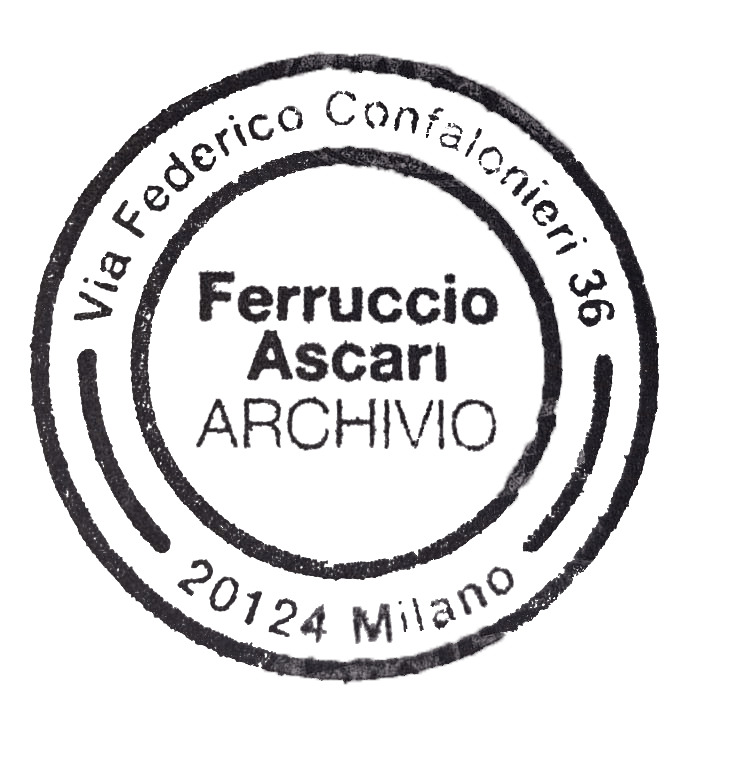Lingua: English
-
2017 Rumore
20
Rumore
-
2016 Falso Allarme
20
16Falso
Allarme
[Video]The video is a sort of camera obscura, where through a hole, which is simply our eye, a sequence of images unfolds at a dizzying pace.[read]They are images captured in motion from the window of a speeding train – our life? – that catch only fragments of a view deprived of its completeness. The soundtrack, which as always in this cycle of videos by Ferruccio Ascari is not a secondary element, contributes to suggest the idea of a flight that seems to have no precise destination or aim. The only element shared by these flowing images is the speed with which they appear on our visual horizon and then vanish.[/read]
Falso Allarme, 02’43”, 2016 (teaser 0’33”)
Click here for the full video
-
2016 la freccia che colpisce il bersaglio vola per sempre Video
20
16La Freccia che
Colpisce il Bersaglio
Vola per Sempre
[Video]The title The arrow that strikes the target flies forever refers to two videos – one of which is a loop – both based on a sculpture of the same title[read] by Ferruccio Ascari from 2007, made of four pieces of white terracotta.
Each piece is composed of a series of concentric truncated cones, of diminishing diameter, nested inside each other. The concentric circles, sloping inward, attract the gaze, sucking it towards an infinitesimal inner point, an imaginary vanishing point in which the gaze penetrates, giving rise to a visual vortex. The gaze is comparable to an arrow that encounters no obstacles and thus flies, as the title suggests, forever, infinitely. A gaze without an object, that vanishes into a void in many ways comparable to the condition reached in a meditative mindstate. The soundtrack uses the sounds produced by striking each individual part of the sculpture.[/read]La Freccia che Colpisce il Bersaglio Vola per Sempre, 2’22”, 2016 (teaser 0’34”)
Click here for the full video
La Freccia che Colpisce il Bersaglio Vola per Sempre, loop, 2016
https://vimeo.com/152171877
-
2016 Muri
20
16Muri
[Video]The video, like two others belonging to an earlier period – Promethèus and Artisti contro il nucleare (Artists against nuclear power) – conveys a strong political message,[read]starting with the title that alludes to a precise phase of recent history: the one marked by the migratory movements of populations victimized by war or inhumane living conditions towards the European nations and elsewhere.
The wall is what separates, blocks the view of what happens every day in silence, in the midst a general lack of attention: deaths on the workplace, wretched lives, without the possibility of escape, that obscure the image of progress and efficiency of an era that is actually incapable of imagining and designing the future. The structure of the video itself, the purely visual plane, conveys these reflections: the obstacle to viewing is that of worksite barriers with holes at many points. Through each of these small openings one can glimpse for an instant a series of catastrophic events whose tragic impact, precisely through repetition, is canceled out, producing inurement instead of rebellion. An obsessive repetition that returns in the soundtrack that accompanies the video: a soundscape that evokes the construction site, the factory, the repetitive nature of industrial work.[/read]Muri, 02’39”, 2016 (teaser 0’28”)
Click here for the full video
-
2015 Quiescente Obliqua I
20
15Quiescente
Obliqua
2015The two videos – QO1 and QO2 – were made by Ferruccio Ascari from the visual and sound materials of the installation / dance-performance Quiescente Obliqua 1981-2015[read]presented at the exhibition Light: Science Cinema Art promoted by the University of Parma in 2015, proclaimed by the UNESCO International Year of Light. Quiescente Obliqua was presented for the first time at the National Gallery of Modern Art in Rome in January 1981. The cornerstone of this work, exemplary of the climate of research of those years, is the interaction between different linguistic levels through the activation of a dense network of relationships between body movement, light, sound, and space. As in the 80’s, in this new version is on stage Gustavo Frigerio: his dancing body and his voice animate the score / architecture of luminous signs made by Ferruccio Ascari through the projection in the space of a set of slides obtained by drawing directly on the film: the projection ‘built’ a virtual environment. Visuals elements are intertwined to the suggestion of the voice work and the sound track produced, for this particular occasion, by the composer Nicola Ratti. These are also the fundamental elements of the two videos: through a restructuring of the visual and sound materials of the performance in 4 ‘and 11″ the protagonist makes a sort of journey through memory and time starting from the suggestions offered by some sentences extrapolated from the Ulysses of Joyce that, transformed by Ferruccio Ascari in writings of light, go through the scene like lightings.[/read]
click here for interview by Marco Marcon
Quiescente Obliqua. Dance performance, mixed media, Palazzo del Governatore, Parma, 2015 [PE0019]
Pictures by Donata Clovis
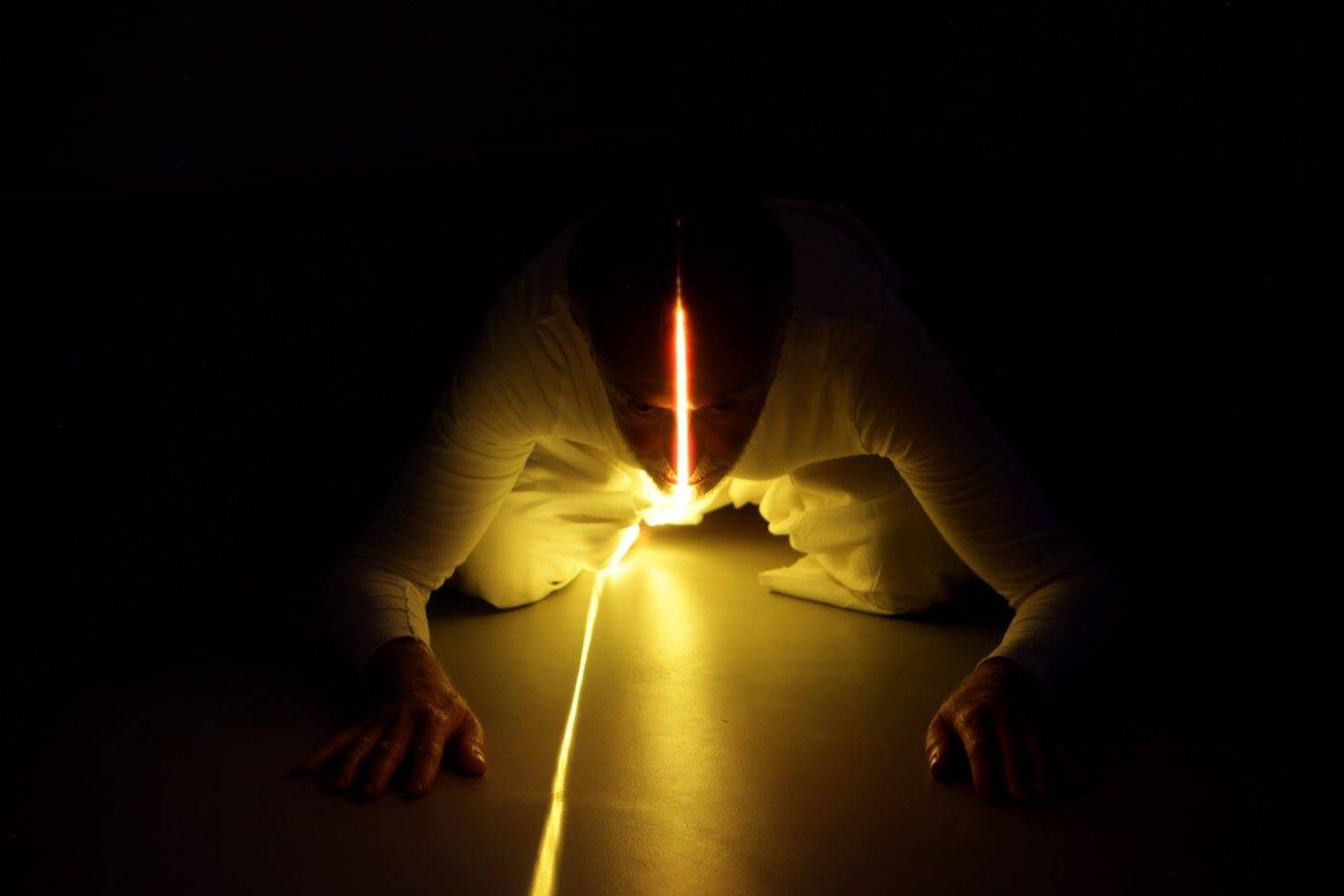
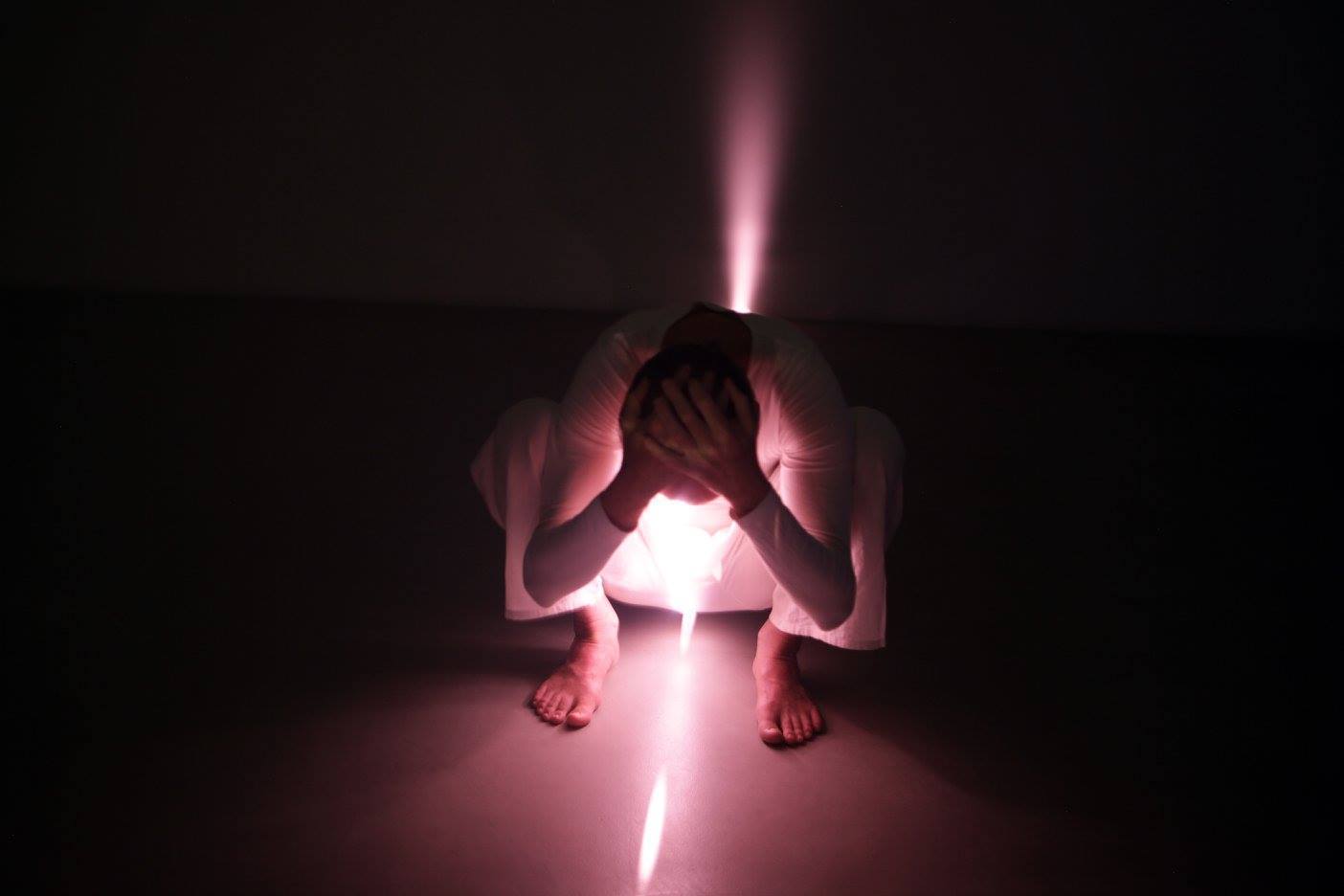
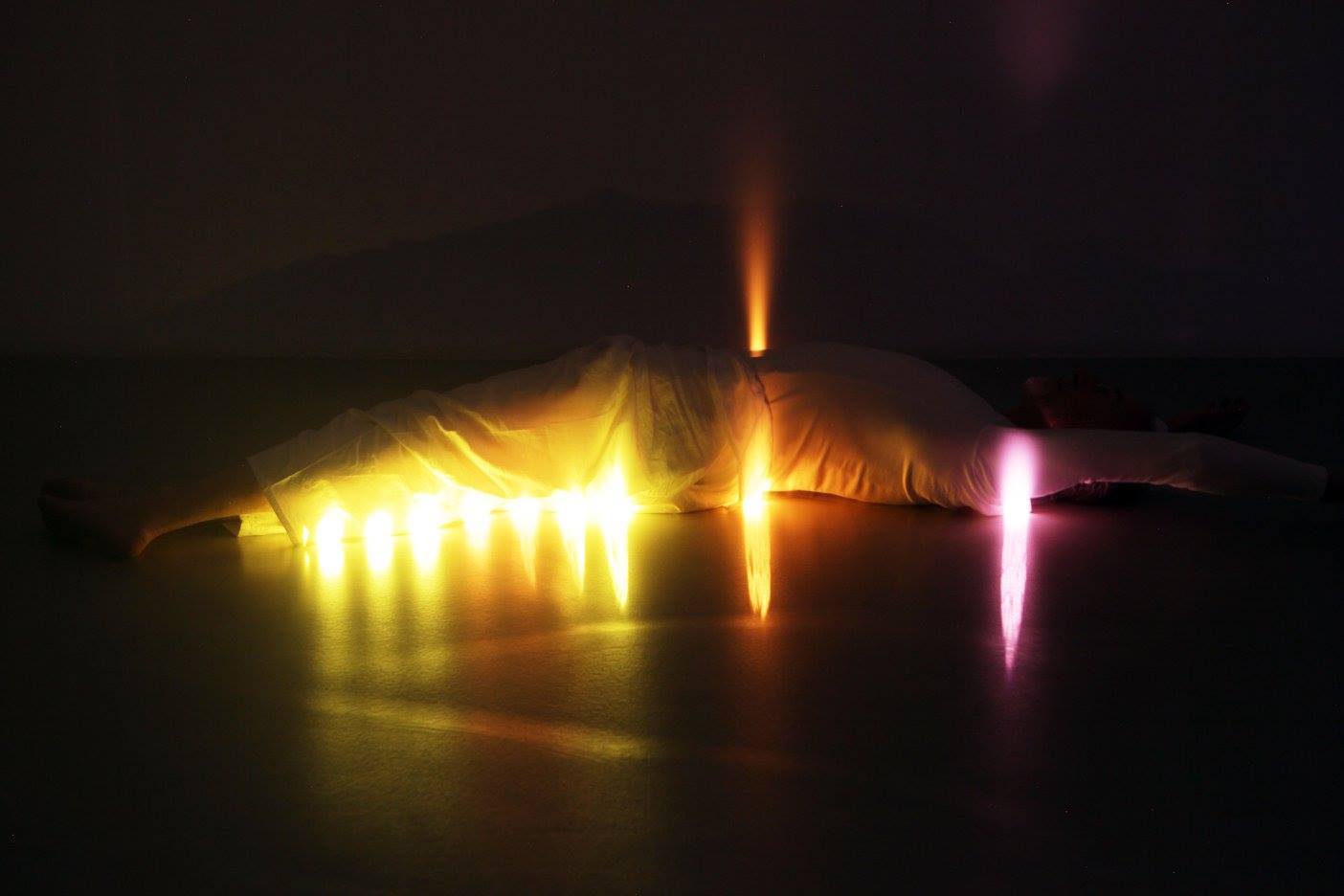
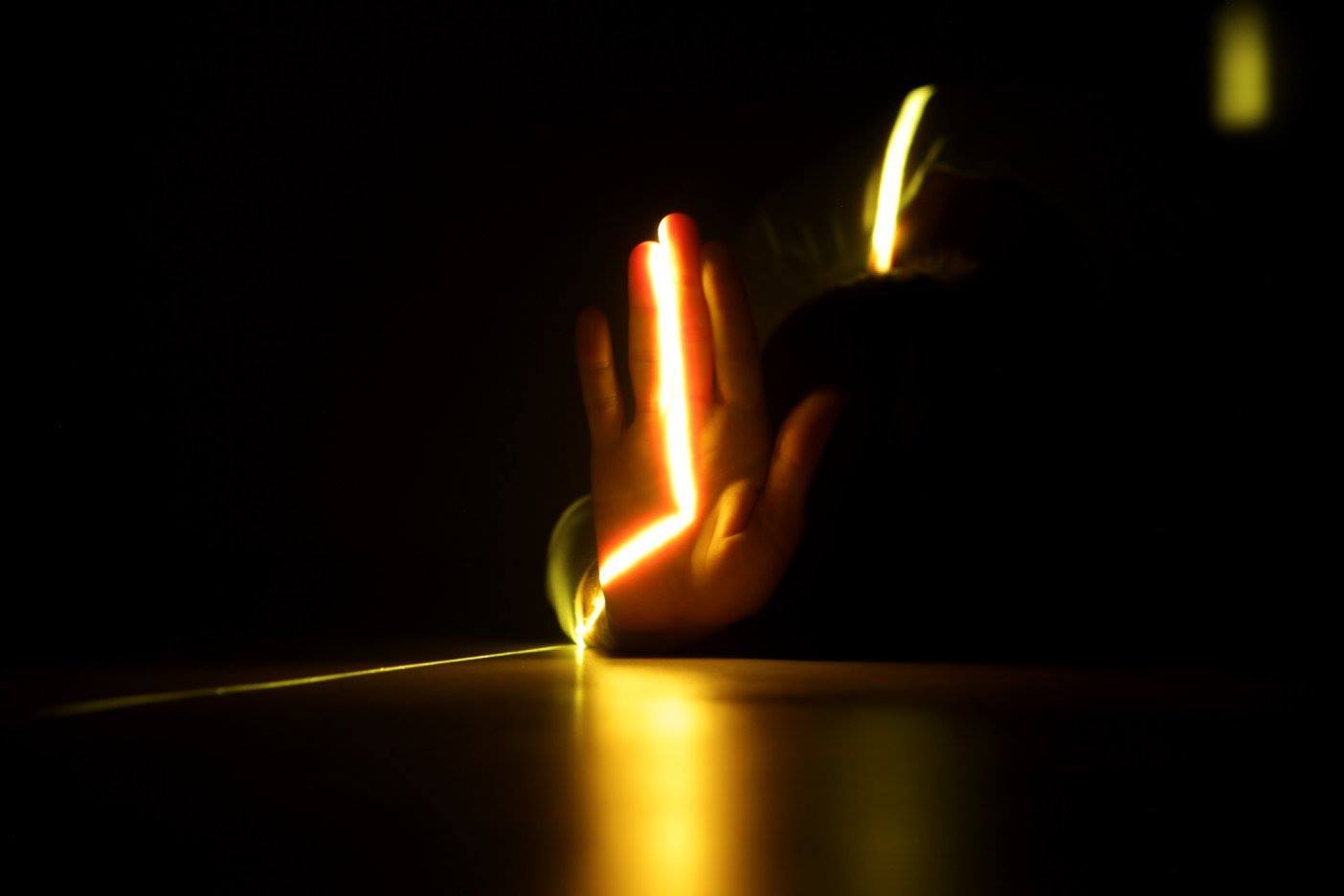
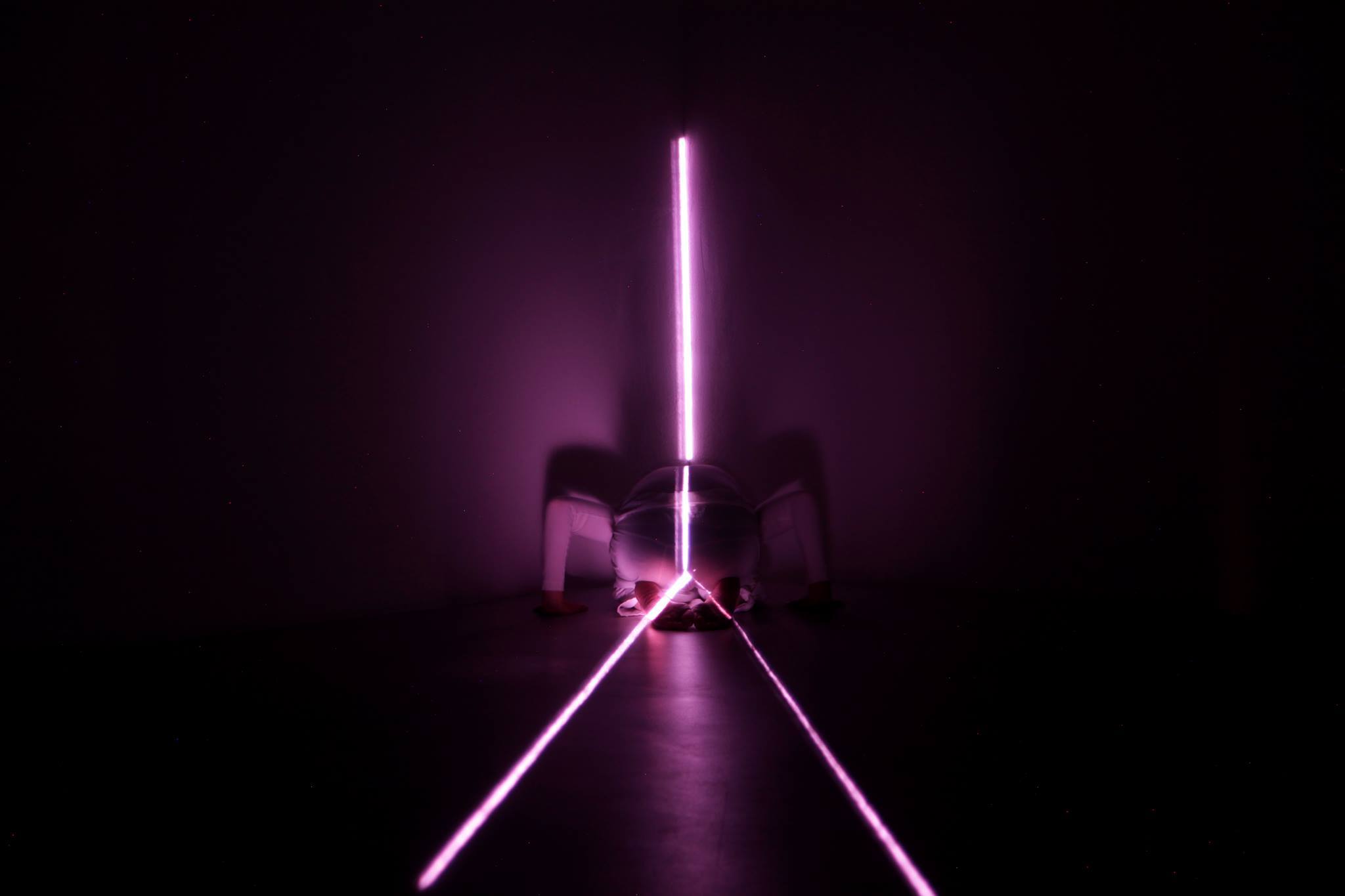
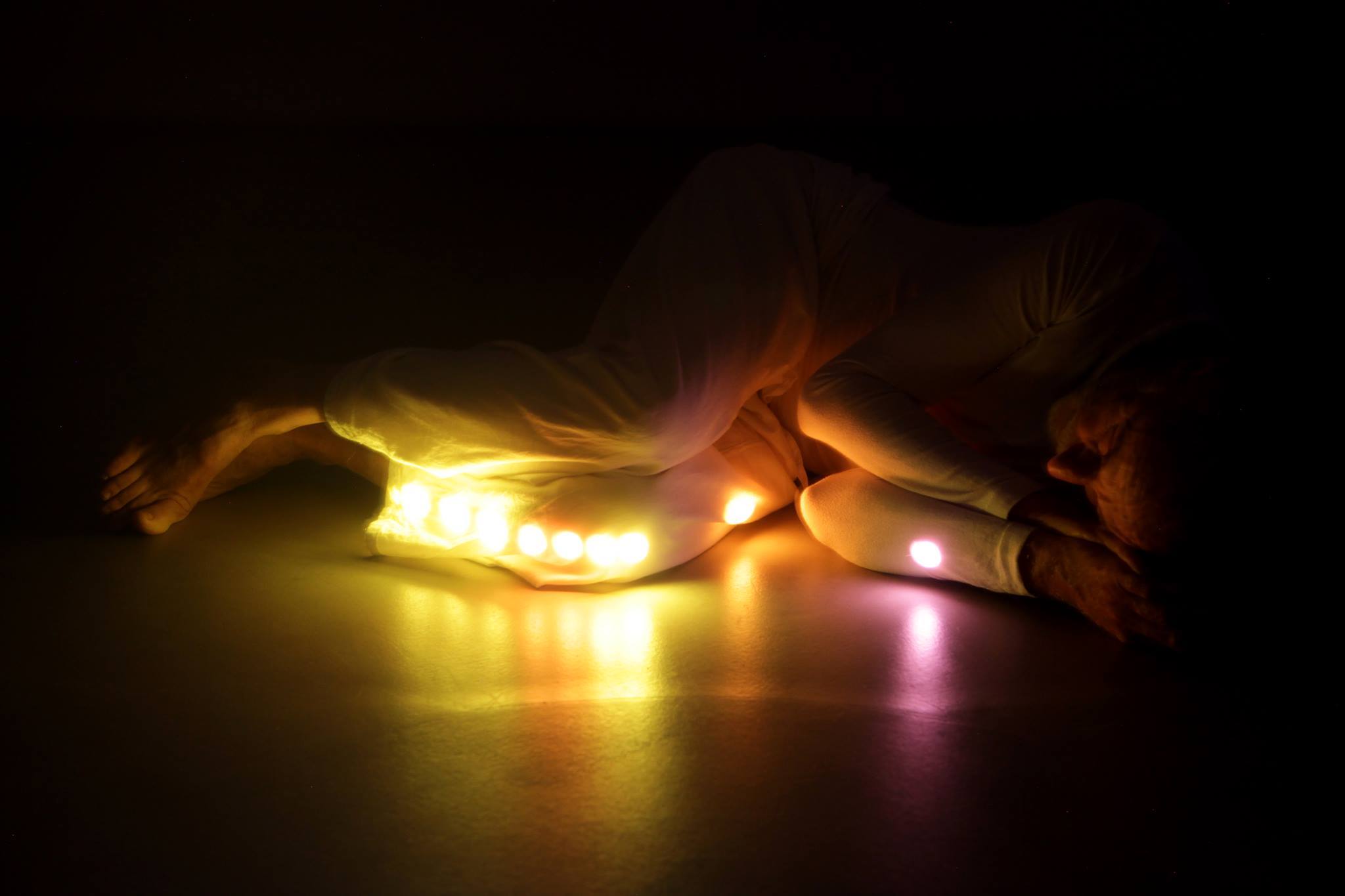
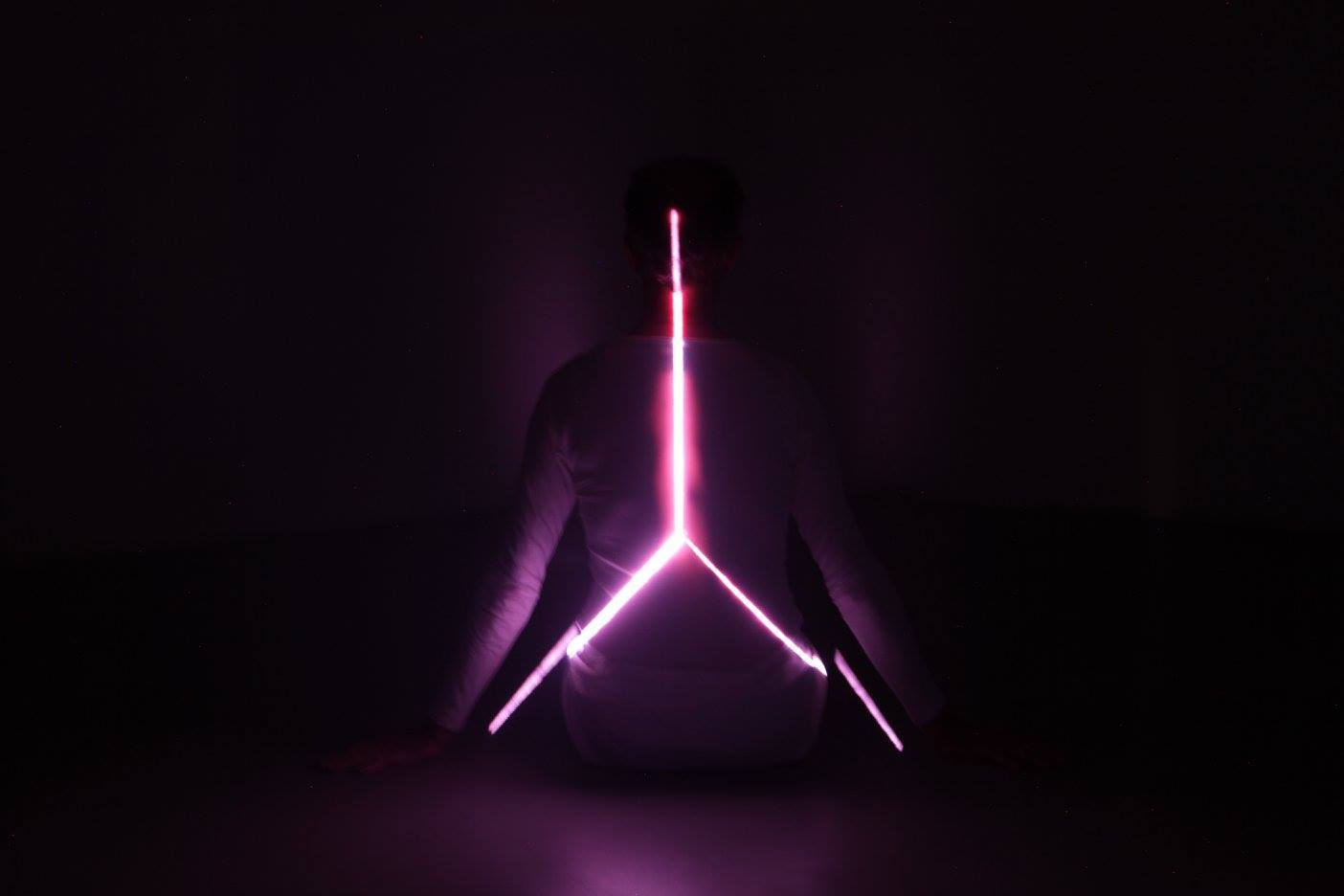
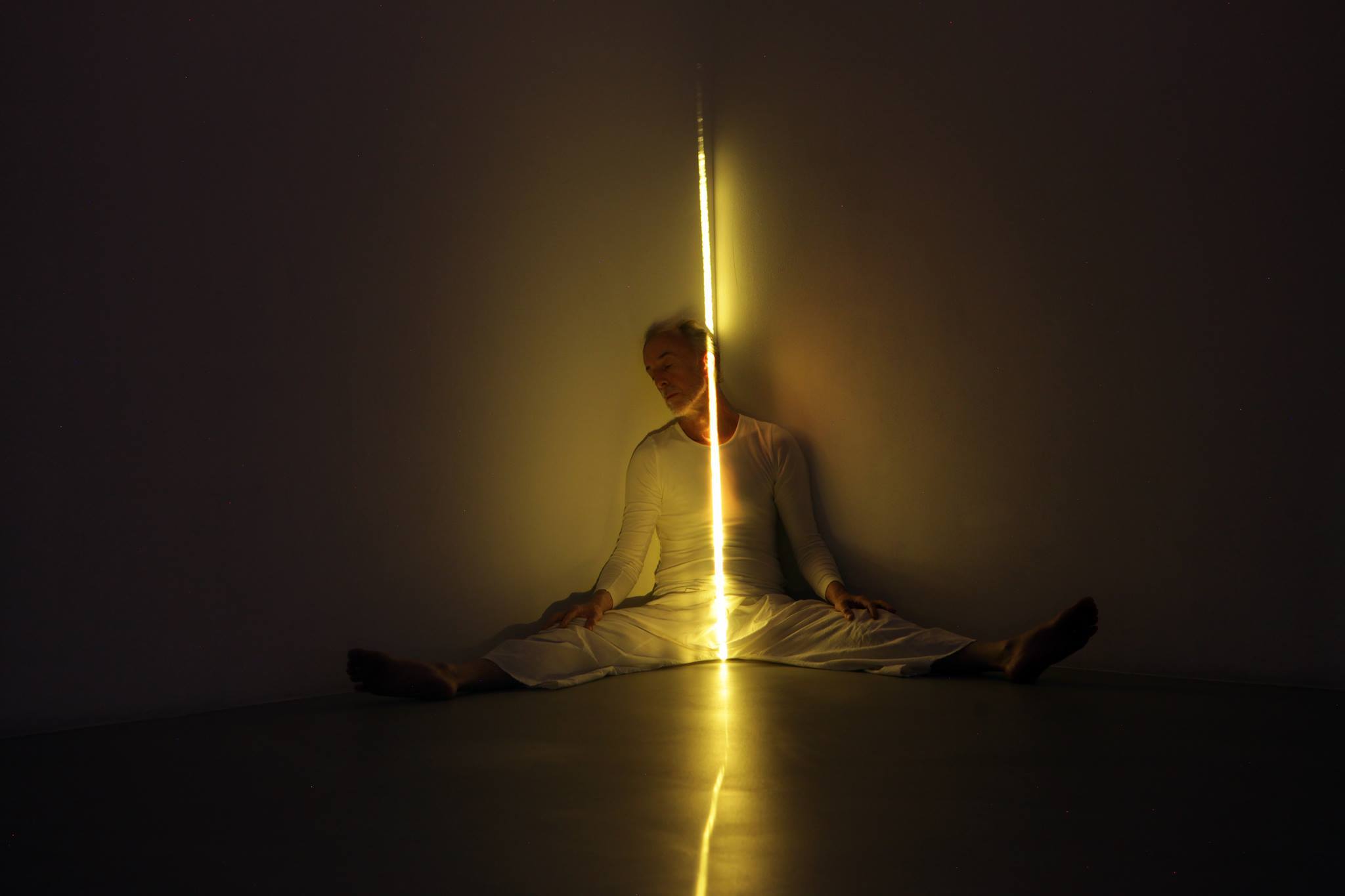
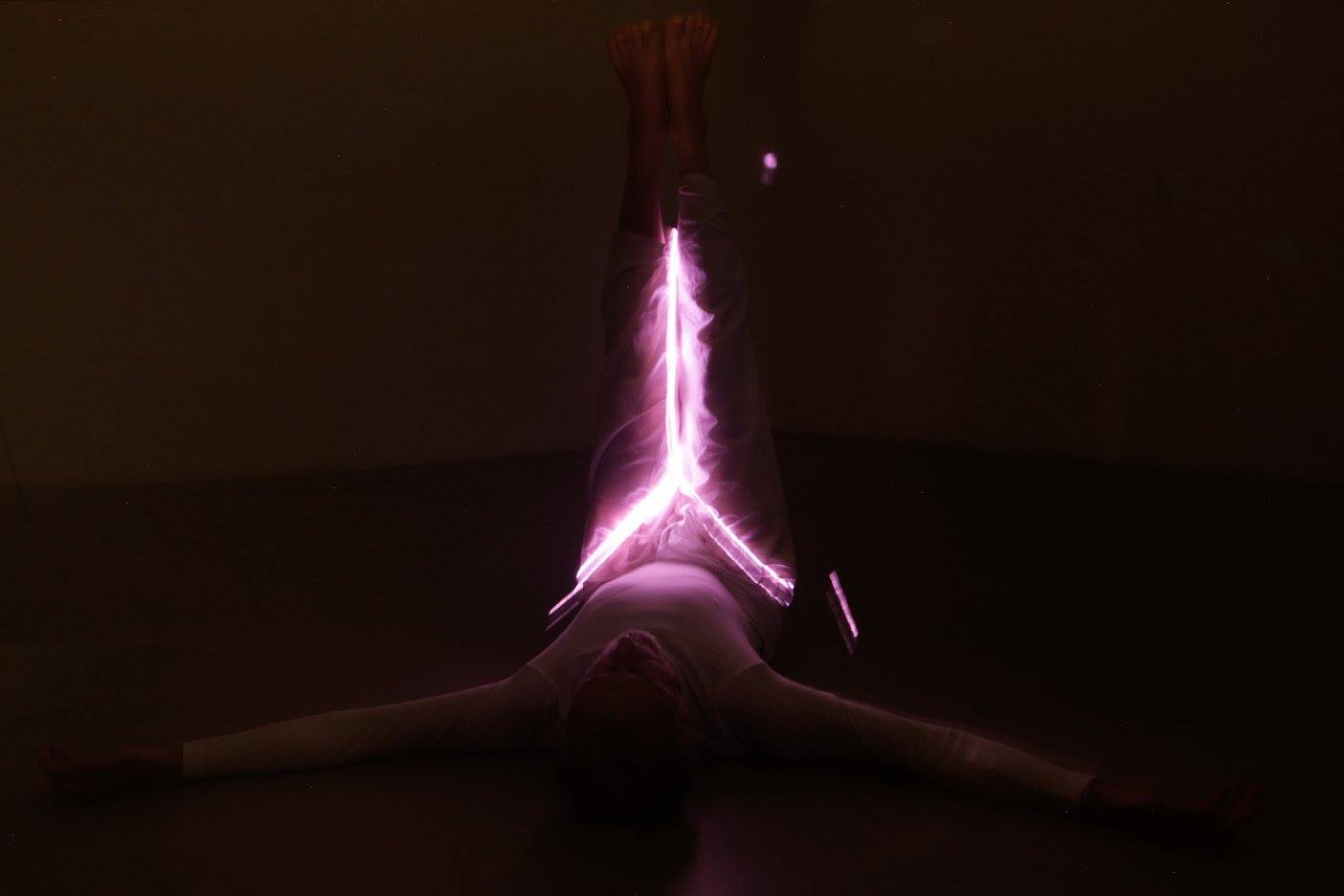
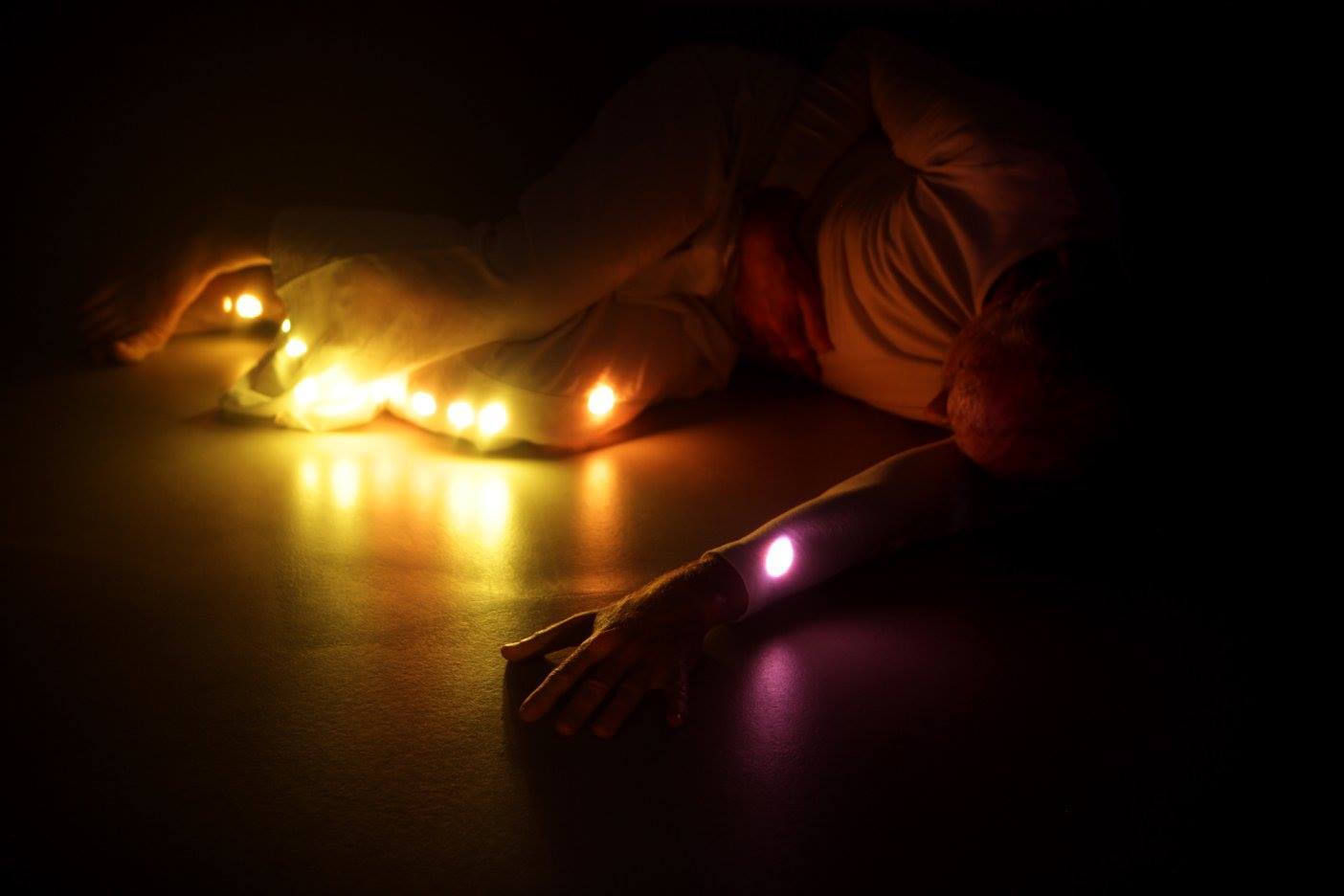
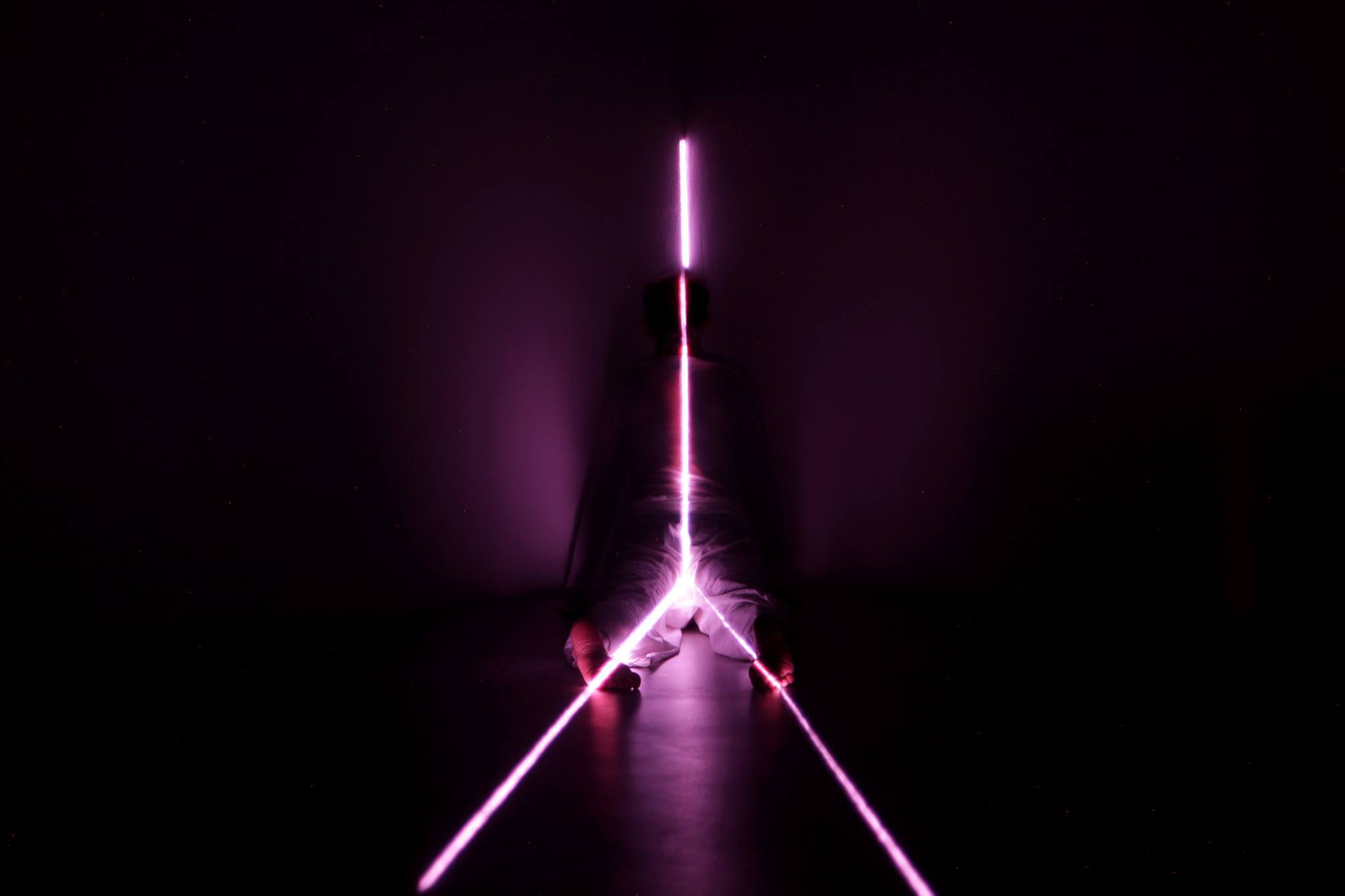
Quiescente Obliqua II. 04’12”, 2015 (teaser 01’14”)
Click here for the full video
-
2015 Related Video: Vibractions 1978-2012
20
15Vibractions
1978-2012
[Video]Combining recent and archive footage, this video presents two different versions of Vibractions, installation/performance from 1978 presented in a new version in 2012 at Casa Anatta, Monte Verità,[read]on the occasion of a solo show of the artist at the Museum of Modern Art in Ascona.
In Vibractions, installation/performance presented for the first time in Milan in February 1978, the visual and sound elements were closely connected within the conceptual framework of a reflection upon the categories of time and space. The paradoxical aim of Vibractions was to measure the architectural space by means of sound, or rather to find a sound equivalent of the architectural space. Site-specific and ongoing, Vibractions was presented in different locations through the years, reaching different results every time based on the peculiar features of each venue. Therefore, the video spans a period of time from 1978 to 2012, combining recent and archive footage in a way that conveys the passing of time while at the same time reaffirming the conceptual vitality of the work.[/read]ated Video: Vibractions 1978-2012. 06’34”, 2015
https://vimeo.com/117893518
-
2015 affreschi strappati
20
15Frescoes
Transferred
To Canvasclick here for a text by Giorgio Verzotti
Untitled, fresco transferred to canvas, 90×100 cm, 2015 [A0238]

Untitled, fresco transferred to canvas, 90×100 cm, 2015 [A0239]

Untitled, fresco transferred to canvas, 90×100 cm, 2015 [A0240]

Untitled, fresco transferred to canvas, 90×100 cm, 2015 [A0241]

-
2015 Mano Armonica Video
20
15Mano
Armonica
[Video]Music score written on the hand fingers—executed for the first time in Milan in 1978 as part of the installation/performance Vibractions,[read]versions of this work were presented through 2012 in different locations.
This video stems from a work from 1978 of the same title, composed of twentyfive photographs of the artist’s hand. The fingers, bent in different positions, are the support of a music score executed for the first time as part of Vibractions, a sound installation/performance from the same year, presented in different locations and versions through the following years most recently in 2012. In the video, the music score and the hand’s movement are once again closely interconnected: the movement of the fingers generates the score, which by turn becomes the animation’s sound track.[/read]Mano Armonica, 03’09”, 2015 (teaser 0’50”)
Courtesy: Museo del Novecento – Milano
Click here for the full video
-
2015 Memoriale Volubile Video
20
15Memoriale
Volubile
[Video]Memoriale Volubile , the 1st chapter of Restless Matter, takes its cue from an installation made by Ferruccio Ascari, in its first version in 2009 at Darmstadt, for a solo show at Museum Schloss Lichtenberg.[read]The work, in keeping with the characteristic process of the artist, was later developed in a series of variations in relation to the various places where it was shown. Its constituent parts, as happens in this video, are subject to continuous transmutation: they are light, disturbing object/sculptures in which relationships are established, without reconciliation, between transparency and opacity, beauty and ruin; forms that conserve a link to the organic world but also seem to belong to some alien realm. The title – Memoriale Volubile (Fickle Memorial) – sheds light on the work’s genesis: the horror of the series of environmental disasters that have marked our time and the desire to keep their memory alive by combatting forgetfulness, inurement to disaster. The title, as the artist explains, is a “combination of two words with opposing meanings: ‘memorial’ which pertains to recollection or the prompting of memory, and ‘fickle’ which instead points to distraction, forgetfulness […] A formula that wavers between an impossible marriage of opposites and their inextricable conflict.” The soundtrack, an important part of this stop motion video, is taken from Vibractions, a sound installation by Ferruccio Ascari from 1978.[/read]
/
Interview with Ferruccio Ascari, February 2009[read]
Memoriale Volubile: what does it mean?
It is a contradictory expression, the combination of two words with opposing meanings: “memorial” which pertains to recollection or the prompting of memory, and “fickle” which instead points to distraction, forgetfulness. An expression invented by joining two words with contrasting meanings, wavering between an impossible “marriage of opposites” and their inextricable conflict
In this exhibition we find Memoriale Volubile imprinted on the cover of several white books placed in vitrines, and on cardboard boxes that support metal screen sculptures: so this is a title that repeats, differentiated only by its accompanying serial number. Could you explain the type of seriality indicated here?
Title and image, name and thing are inseparable here. The expression Memoriale Volubile explains – in its irreconcilable ambiguity – the image, the thing, just as the latter explain the expression. This crossed relationship unfolds in the repetition, the serial effect: the seriality evoked by “word and thing” is a tragic series, before everyone’s eyes. It is the infinite series of environmental disasters, for which we have lost track of the quantity, but of which we cannot lose the memory. Precisely the wavering between memory and its erasure is the contradiction that Memoriale Volubile, in its own way, wants to indicate.
Books in vitrines, sealed, that cannot be read…
…books of horror, illegible books, memorials whose covers bear only the image of a place, its name – Chernobyl, for example – and the date of the disaster. Nothing more. I believe this suffices to evoke a horror that is intolerable for any conscience.
Light and at the same time disturbing sculptures. Symmetrical objects, but with an unstable, off-balance symmetry, as if teetering on the brink of an abyss. As if they were in danger, or dangerous. Things in which a relationship is established, without reconciliation, between transparency and opacity, beauty and ruin. What prompted you to invent such forms?
It was sudden, as if on the spot I felt the need to depart, to go on a journey. To leave what I was doing. To go away: a mental voyage, a terrible voyage. I began to search online for those places of memory, places of horror: Vajont, Seveso, Bhopal, Mururoa… an interminable, bewildering journey. And a very concrete one. Nothing virtual about it. One day I began to download images of those places, from the sites I was visiting. More and more photographs of those disasters. They accumulated. A compulsive gesture, as if dictated by the fear that the number of those images would be infinite, and by the desperate desire for it to have an end…
…are those the images that appear on the frontispiece of the white books placed in the cases… and the sculptures?
I felt like the inurement to disaster was unbearable, that danger that those places could be forgotten. Those places, the name of each of them, should be repeated out loud, every day… And yet the voice, speech, is not enough. At least for me, someone who plays with form…
…you play?
Do you know of anything more serious than play?
Agreed. But let’s get back to those forms, their restlessness, their genesis…
…a form, prior to representing anything, presents itself, displays itself. Necessarily. This necessity of the form to reveal itself fascinates me, because it points to a concealment. Without this concealment no unveiling, no manifestation would be conceivable, there would be no “coming to light.” The same dialectic, the same game as between speech and silence. But I am digressing… You want to know something about their birth: I have thought about the forms that could become a warning (and maybe also become monumental), that could attempt, in any case, an opposition to the tendency to forget. I wanted to put them beside those names, those places, those dates, precisely as an admonition.
The choice of placing these sculptures on cardboard boxes conveys the idea that they have just arrived from who knows where, or that they are about to depart: could you tell me something about this installation?
The relationship between a sculpture and its base is rarely a simple one. Actually it is a very difficult relationship. Usually I put my works directly on the ground. In this case, though, the sculptures – especially the small ones that most clearly reveal their character as projects – could not stay on the ground; they wanted to be observed from a different perspective. Placing them on the boxes I had in the studio was the most simple, natural gesture, and it worked. There is something transitional about this placement. As you correctly point out, a desire to move, to change location, like an urgency…
Allow me to make another observation: these forms of metal screen seem somehow connected to a scientific imaginary… a science that seems to be infiltrated by an evil disposition. Am I mistaken? Normally you use natural materials. In most of your work it is possible to glimpse a relationship with the organic world… And while it is true that the forms displayed here could belong to some natural realm, it would in any case be an alien realm, of a nature issuing from a mind dominated by a sort of disquieting scientific obsession…
…you are not mistaken. I must admit that a natural form usually intrigues me more than an artifact or an industrial product. Often a natural form seems to ask me: do you know where I come from, do you know why I have the form that I have, can you predict the form I will assume as I transform, do you understand what moves me? I know that I do not know: and that is precisely what drives me. In my work, in any case, I feel free to use anything that can serve to say what I want to say, without any preconceived limitations. Here, in Memoriale Volubile, the nature I address is a wounded, offended nature. A nature in agony. An agony that cannot be separated from the “disquieting scientific obsession” you mentioned. Exposed to that obsession, these forms are contaminated. You said “an alien realm”: no, here you are mistaken. If these forms speak of alienation, that alienation, that madness is not of another world, but this world. They are forms of madness: mad forms of pain. An unbearable pain. That can no longer be withstood.
So, on closer examination, can we see a political position, in the end, in this latest work of yours?
Can I ask you a question, at this point? On closer examination, is there anything people do or undergo – consciously or unconsciously – that is done or undergone outside of politics?[/read]Memoriale Volubile. 04’21”, 2015 (teaser 01’01”)
Click here for the full video
Memoriale Volubile, Backstage, 01’31”, 2015
The video shows the phases of work that led to the making of Memoriale Volubile: from paper drafts to metal screen sculptures, all the way to the moment when they “take flight, frame by frame” in the artist’s studio. The soundtrack develops in a crescendo and then a diminuendo of sounds, released by the materials during the work.
https://vimeo.com/131745353
-
2014 impermanenza
20
14Impermanenza
(english version coming soon)
Senza impermanenza, la vita non sarebbe possibile : un seme non potrebbe crescere, un fiore non potrebbe trasformarsi in un frutto un bambino non potrebbe diventare adulto.[read]Anche la nostra personalità, il nostro io è solo un nome, che copre una moltitudine (un flusso) di elementi psicofisici in relazione tra loro – non limitati alla vita presente ma radicati in esperienze passate e proiettati in quelle future. L’individuo è una combinazione di forze od energie psico-fisiche, in continuo mutamento. Perchè in questo divenire senza inizio nè fine immaginiamo cose piuttosto che processi? Chiudiamo gli occhi davanti alla successione degli eventi: La vita non è una cosa, né uno stato, ma un continuo movimento e mutamento: nulla è ora lo stesso di come era un attimo fa.
Il nostro stesso “io” è un complesso di sensazioni, idee, pensieri, emozioni e in continua trasformazione ed evoluzione.
Secondo l’opinione corrente, la permanenza dà sicurezza, l’impermanenza no.
Pensiamo che cambiamento equivale a perdita e sofferenza : vogliamo disperatamente che tutto continui così com’è. In realtà, invece, l’unica cosa durevole è paradossalmente proprio l’impermanenza. E la nostra lotta per trattenere le cose così come oggi sono non solo è impossibile, ma – ironicamente – ci provoca proprio quella sofferenza che vogliamo evitare. L’errore sta nel fatto che – per essere felici – ci afferriamo a ciò che è per natura inafferrabile2. Invece di aggrapparci disperatamente alle cose e tenerle strette dovremmo imparare ad allentare la presa e a lasciar andare : In realtà, il mondo è come il susseguirsi dei fotogrammi di una pellicola cinematografica : non c’è nessuna sostanza che abbia una durata ; e gli elementi non mutano, ma scompaiono. Ne consegue la negazione del movimento : un elemento non può muoversi, poiché scompare non appena è apparso e quindi non c’è tempo perché possa muoversi. In effetti, quello che chiamiamo movimento è una serie di manifestazioni separate o lampeggiamenti che sorgono contiguamente l’uno all’altro, cioè apparizioni consecutive di nuovi elementi in nuovi posti. Tale divenire non esclude però l’impressione di una durata o continuità che – in realtà – non esiste.
E’ impossibile possedere le cose (o le situazioni) perché queste ci fuggono in virtù della transitorietà e dell’ impermanenza. E chi crede di riuscirci, si illude come colui che tenta di fermare il tempo spaccando l’orologio.[/read]Impermanence and environs: Elena Scardanelli interviews Ferruccio Ascari[read]
I wanted to talk with you a bit about Impermanenza, the installation you made in 2013 for the exhibition curated by Asilo Bianco at Museo Tornielli in Ameno, and about the video that has come out of this work, which in turn is part of a larger, more complex project, namely Restless Matter, a work in progress you have created for the web. Before asking you more specific questions about the work, I’d like to make an observation of a more general character regarding the project, the thought that seems to permeate it, to see if you agree. This requires a preamble. “Impermanence,” besides being the title of one of your works, is also a category, a key concept of Buddhist philosophy based on the observation that what constitutes every existing thing is simply a set of elements in relation to each other, transient and subject to continuous change: everything has a beginning, and an end. I think I can say that Restless Matter, the thought and the creative working method of the whole project and each of its constituent videos, has come into being under the sign of impermanence. I would like to know if you agree with this interpretation.
There is no need to look to the Far East to discover that impermanence is the true nature of all things. The Greek philosopher Heraclitus, to remain in our cultural zone, is already credited with the warning “everything flows,” the idea that “you cannot step twice into the same stream.” After all, reflection on the evanescence of things lies at the basis of much of Western thought and mysticism. I know little about Buddhism, but instead for some time now I have been interested in the philosophy behind yoga. In any case, I don’t believe that in an artistic work there has to necessarily be a concept that comes before, followed by an implementation. I much prefer to think of art as “thinking while doing” or “doing while thinking.” One day in the country I observe a pile of firewood and I “see” something I have never seen before: I still don’t know just what, but to give form to that initial intuition I start to take the pile apart. Taking things apart to figure out how they work is a child-like attitude I’ve never outgrown. Then I decide to put it back together, but instead of making a square base, with the logs at the bottom placed in one direction, those of the next layer placed crosswise, and so on in alternating layers, as woodpiles have always been made, I let myself by guided by the idea of the “triangle”: so I start to pile the logs on a triangular base, which is much less solid but turns out to be more and more fascinating, as the pile grows, precisely due to its precarious quality. Impermanenza is a work that starts like that, and then gets gradually refined in the months to follow. What I mean is that this, like almost all my other works, does not come from an abstract concept, but from a sudden “glimpse” of something I never saw before. The idea was already there in that form/woodpile, as if it was just waiting to be “seen” and trans/formed, to bring out a hidden aspect of its innermost nature.
The installation you did for Museo Tornielli is composed of architectural towers made with portions of branches, stripped of their bark and painted white. It conveys the sensation of something that almost through a miracle of statics, or in astonishing defiance of it, might remain standing for just a moment: the pieces of wood speak of a previous collapse and an inevitable coming collapse. What did you want to express through this work?
More than a desire to express, I think the attitude is one of listening, investigation, bringing what is hidden to light. Every form, every material contains its own secret. To interrogate a form, to torment a material, to push a tension to extremes, to take a structure to its limits: this is what I do when I work. In the case of Impermanenza what is taken to the limit is balance. If there is the desire to express something, that something lies precisely in “being at the limit.” On the verge of collapse. I believe the intention is not so different from that of the tightrope walker on his rope stretched across the void, or – less dangerously, but with a similar spirit – of a child building a house of cards. The gratuitous nature of play is essential, meaning not being subjected to utility. Play, like art, is a serious matter precisely because it eludes utility. Play is not useful, it is indispensable: which are two different things. Here the fall, the collapse, the ruin are indispensable, otherwise the game could not be played. The fall is intrinsic, though it can be hidden by appearances, in the balance itself. It is the true “repressed” part of the solid edifice everyone wants to display, rather than its ruin. Just the opposite of what is displayed by the towers of Impermanenza.
Is there any reference in this work to the myth of the Tower of Babel?
Who knows? I certainly do not have the ambition to “touch the sky” with a flimsy woodpile, but I can’t be held responsible for the interpretations of others…
The portions of branches stripped of bark and painted white, which serve as the construction material of the three towers, are strikingly similar to bones: animal bones, cleaned and polished by time. I won’t conceal the fact that when I saw this work I couldn’t help thinking about Capuchin crypts, the compositions of bones that adorn their chapels. But I don’t think that the theme here is that of the “memento mori” typical of the Catholic tradition. What do you think?
I think the theme of death is not completely absent in Impermanenza: while I was making it, the idea of the ‘”ossuary” did gradually take form, in effect, giving consistency to ancient fears and faraway fascinations. When I started to handle those sticks, in their raw state, with lichen all over them, with their smell, I sensed that they were elements that in spite of the fact that I liked them, might be overwhelming something essential I still was not fully aware of. It was as if they needed some kind of calcination process: hence the white, which clearly reveals the tendency of those sticks to become a sort of bone. Secondly, the white banishes the risk of a certain Arte Povera mannerism.[/read]Impermanenza. Environmental installation, variable dimensions, Museo Tornielli, Ameno, 2014 [S0032]









Video documenting the installation at the Tonielli Museum. 2’27”, 2005
